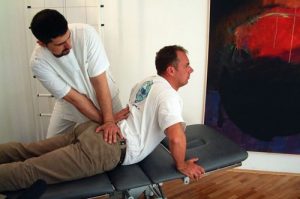MANUAL MEDICINE
Manual medicine is an irreplaceable biomechanical method in the correction of the spine and other deformities of the musculoskeletal system. With an expert passive stretching, we significantly increase the range of joint movements. By doing so, we activate the muscles in their entirety and balance the activity of that part of the musculoskeletal system (mostly the spine). Let me give you an example. If you raise a weight in the full range of movements, you are strengthening the muscle. If you are doing this in a reduced range, you are forming the muscle in the wrong way. And if you are doing this raising the weight only “half-way” – you are only tiring the muscle. Therefore, manual medicine plays a key role in the correction of kyphosis, scoliosis, poor posture and other deformities of the musculoskeletal system because the patient cannot achieve the full range of movements or the activation of muscles in order to implement the correction with individual workouts only. In addition to the already mentioned benefits, manually increasing the range of movements in sports medicine gives a significantly better amortisation of the load. With better elasticity we can achieve faster muscle activation (higher speed and higher agility). It is clear how important these elements are in sports and in life. If biomechanical therapy is not applied in time, the soft tissues of the spine degenerate irrevocably, and the bone tissues deform gradually. Their function regresses irrevocably.
Manual medicine (chiropractic) is a method in which we push protruding cartilage plates (spine discuses), releasing the compressed (“pinched”) nerve roots and other nearby sensitive structures. In general, we put joints and their belonging structures in the right position. By manually stretching the connective and muscle tissues we also contribute to the balance of the musculoskeletal system, better positioning of its parts and often the functioning of the system as a whole. Therefore, for example, even when we cannot move the protruding discus, we can often, using manual medicine and the said method, repair the position of the neck or lumbar part of the spine in relation to the compressed nerve root and thus significantly reduce physical suffering and pain such as neck pain, pain and numbness in the arms, dizziness, headache, pain and numbness in the legs, weakness of the arms or the legs … With manual stretching, we improve the function of the stretched part of the musculoskeletal system, but also the function of all other systems connected to it (the respiratory system, cardiovascular system (including the lymphatic system), urinary system, endocrine system (anti-stress) …). In order to achieve the targeted range of joint movements in manual therapy, we use heating techniques (balance table, massage, paraffin, and infrared lamps), relaxing (hydro-massage …) or previous stretching on an electronic traction (extension mat). Besides therapy, other techniques of manual medicine include the same diagnostics. In this way, by testing specific movements, we discover the way with which we can improve the status of, for example, sciatica or dizziness. By doing so, we spare our patients from expensive and damaging diagnostic procedures and we reduce the time of recovery significantly!


